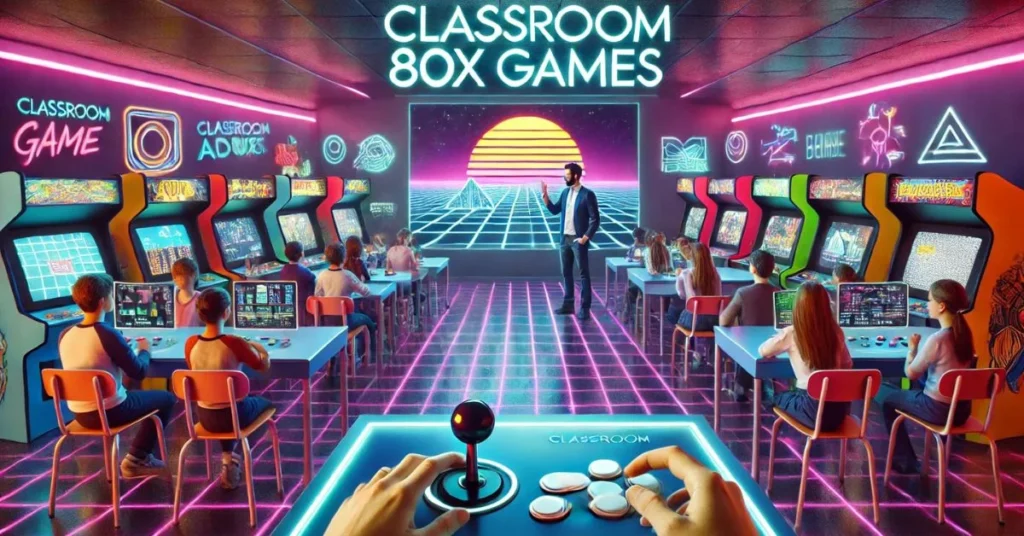Welcome to a journey where retro gaming meets modern education! In today’s fast-evolving classroom environments, educators are increasingly turning to innovative techniques that not only make learning fun but also tap into the power of nostalgia. Classroom 80X Games explores how classic 80X games are being integrated into educational settings to boost engagement, enhance cognitive skills, and build a bridge between past and present learning experiences.
Introduction
Overview of 80X Games in Education
Imagine the sights and sounds of the 1980s—arcade cabinets, pixelated graphics, and the unmistakable beep of early video games. These 80X games are more than just a blast from the past; they carry a unique charm and simplicity that many educators are now leveraging. In classrooms, these games have evolved from mere recreational activities to powerful tools that foster learning through engagement and interactivity.
Purpose and Scope of the Article
This article delves into the multifaceted benefits of incorporating 80X games into the classroom. We will explore their historical context, the psychological impact of nostalgia, and practical strategies for teachers. Whether you are an educator looking to spice up your lessons or a technology enthusiast curious about the intersection of retro gaming and education, this comprehensive guide offers insights and actionable tips for successfully blending nostalgia with modern learning.
The Evolution of Classroom Games
From Traditional Methods to Digital Integration
For decades, classrooms relied on textbooks, lectures, and static blackboards. However, as technology has advanced, so too have teaching methods. The evolution from chalkboards to interactive whiteboards is just one example of how digital tools have transformed education. Today, educators are embracing video games—especially those from the 80X era—to create dynamic and interactive learning experiences that resonate with students.
Impact on Modern Teaching Strategies
Integrating games into education has proven to boost motivation, improve retention, and encourage problem-solving. These strategies allow teachers to cater to different learning styles, making abstract concepts more tangible. Retro games, with their simple yet engaging mechanics, serve as a perfect bridge between traditional learning and modern digital literacy.
What Are classroom 80x games?
Definition and Historical Background
Classroom 80x games refer to the iconic video games that emerged in the 1980s—a period marked by the birth of many classic arcade hits. These games were characterized by their pixel art, straightforward gameplay, and the pioneering spirit of early digital entertainment. Titles like “Pac-Man,” “Space Invaders,” and “Tetris” not only defined an era but also set the stage for the future of gaming and interactive media.
Iconic Titles and Their Legacy
The legacy of Classroom 80x games is profound. Beyond providing endless hours of entertainment, these games have influenced modern game design and pop culture. Their enduring appeal lies in their simplicity and the universal challenges they present, such as problem-solving under pressure. By invoking a sense of nostalgia, these games remind us of a time when gaming was pure, unfiltered, and innovative.
The Power of Nostalgia in Education
Psychological and Emotional Benefits
Nostalgia has a unique psychological impact. It triggers warm memories, creates a sense of belonging, and can even enhance mood. When students engage with content that reminds them of the past, they tend to be more open, relaxed, and receptive to learning. This emotional connection can reduce anxiety and increase overall engagement in the classroom.
Creating a Familiar Learning Environment
Incorporating nostalgic elements like 80X games can transform the learning environment into one that feels familiar and welcoming. For many students, these games evoke memories of family gatherings, arcade visits, or even early home computer experiences. This familiarity can bridge the gap between the traditional and the modern, making learning more accessible and enjoyable.
Integrating classroom 80x games into Modern Classrooms
Strategies for Incorporation
There are various ways teachers can integrate classroom 80x games into their lessons:
- Interactive Learning Modules: Use game mechanics to explain complex subjects such as mathematics, history, or science.
- Gamified Quizzes: Turn review sessions into competitive quizzes modeled after arcade game challenges.
- Project-Based Learning: Encourage students to design their own simple games inspired by 80X classics, fostering creativity and coding skills.
Adapting Retro Games for Current Technologies
Modern technology allows these classic games to be adapted for today’s devices. Emulators and game development platforms enable teachers to customize games that align with curriculum goals. This technological bridge not only preserves the essence of 80X games but also leverages new tools to enhance learning outcomes.
Educational Benefits of Classroom 80X Games
Enhancing Cognitive Skills and Memory
Retro games require quick thinking, strategic planning, and pattern recognition. These skills are directly transferable to academic learning. When students engage in gameplay, they practice critical thinking and decision-making, which are essential for problem-solving in subjects like math and science. Moreover, the repetitive nature of these games can help reinforce memory and recall, key components of the learning process.
Boosting Student Engagement and Motivation
Incorporating games into the curriculum creates a more dynamic and interactive classroom atmosphere. When learning is fun, students are more motivated to participate. The competitive elements inherent in many 80X games encourage healthy competition, fostering an environment where students are excited to learn and collaborate.
Fostering Collaborative Learning
Many 80X games can be adapted to encourage teamwork. Whether through group challenges or cooperative play, these games teach students how to work together to achieve a common goal. Collaborative learning not only improves communication skills but also builds trust and camaraderie among peers, essential for a positive classroom dynamic.
Challenges and Considerations
Balancing Fun and Educational Content
While classroom 80x games offer significant educational benefits, it is important to strike the right balance. The primary goal is education—not just entertainment. Teachers must ensure that the gameplay complements the learning objectives rather than distracting from them. This balance requires thoughtful planning and a clear understanding of the curriculum.
Addressing Technological Limitations
Implementing retro games in a modern classroom may come with technological challenges. Not all schools have the latest hardware or software required to run these games effectively. Additionally, technical issues such as compatibility and maintenance can pose obstacles. However, with proper planning and resource allocation, these challenges can be overcome.
Practical Strategies for Teachers
Lesson Planning and Game Integration
Successful integration of 80X games into the classroom starts with careful lesson planning. Teachers should design lessons where the game is an integral part of the learning process. For instance, a history lesson might use a retro strategy game to illustrate the complexities of historical conflicts, while a math lesson could employ puzzle-based games to teach logical reasoning.
Resources and Tools for a Retro Classroom
There is a wealth of online resources and tools available to educators:
- Emulators and Simulators: These tools allow classic games to run on modern devices.
- Coding Platforms: Encourage students to modify or create their own retro-inspired games.
- Digital Libraries: Access collections of vintage games and related educational materials to enrich the curriculum.
By utilizing these resources, teachers can create an immersive learning environment that combines the best of both worlds—nostalgia and modern technology.
Student Perspectives on Retro Gaming in Classrooms
Testimonials and Case Studies
Many students have expressed enthusiasm about the integration of retro games into their learning experiences. In classrooms where 80X games have been implemented, educators report higher levels of engagement and improved academic performance. Testimonials often highlight the excitement of experiencing something familiar from their past while learning new, relevant skills.
Survey Trends and Student Feedback
Recent surveys indicate a positive trend among students who participate in gamified learning. Feedback shows that students appreciate the break from traditional lectures and enjoy the interactive nature of game-based activities. This shift in perspective is driving more schools to adopt innovative teaching methods that incorporate nostalgic elements.
The Future of Educational Gaming
Innovations and Emerging Technologies
The intersection of technology and education continues to evolve. With advancements in virtual reality (VR), augmented reality (AR), and artificial intelligence (AI), the potential for classroom gaming is expanding exponentially. Future educational tools may combine the simplicity of 80X games with cutting-edge technology, offering immersive experiences that further enhance learning outcomes.
Predictions for Classroom Gaming Trends
As digital natives enter the classroom, the demand for interactive and engaging learning methods will only increase. We can expect to see a rise in retro-inspired educational games that blend traditional content with modern technological features. These trends will likely lead to more personalized and adaptive learning experiences, ensuring that education remains both relevant and exciting.
Incorporating Other Nostalgic Elements
Music, Movies, and Cultural References
Nostalgia isn’t limited to video games. Incorporating other elements such as music, movies, and literature from the past can further enrich the learning experience. By creating a multi-sensory educational environment, teachers can cater to diverse interests and learning styles, making lessons more memorable and engaging.
Impact on Creativity and Critical Thinking
Exposure to nostalgic cultural elements can spark creativity and critical thinking. When students are encouraged to explore the art, music, and stories of previous decades, they learn to draw parallels between the past and present. This comparative approach not only deepens their understanding of cultural evolution but also encourages innovative thinking and problem-solving.
Balancing Technology and Traditional Teaching
Benefits of Digital Learning Environments
Digital learning environments offer flexibility, accessibility, and a wealth of resources at the fingertips of both teachers and students. The integration of 80X games is just one example of how digital tools can enhance the educational experience. By embracing technology, educators can provide interactive content that caters to the digital age, making learning more engaging and effective.
The Enduring Value of Traditional Methods
Despite the advances in digital learning, traditional teaching methods still hold significant value. Face-to-face interactions, hands-on activities, and classic classroom discussions foster a sense of community and provide a strong foundation for learning. The key is finding a balance that leverages the strengths of both digital innovation and conventional pedagogies.
Policy and Administration Considerations
Budgeting, Resources, and Training
Introducing retro gaming elements into the classroom requires thoughtful investment in both hardware and training. School administrations must consider budget allocations for technology upgrades, software licensing, and professional development programs. Training sessions can equip teachers with the skills necessary to effectively integrate these tools into their lesson plans.
Developing Supportive Educational Policies
For successful implementation, policies must support innovative teaching practices. This includes updating curriculum standards, fostering collaboration between educators, and encouraging pilot programs that test new teaching methods. Administrators play a crucial role in ensuring that both teachers and students have the resources needed to thrive in a modern, technology-driven educational environment.
Conclusion
Summary of Key Points
In summary, the integration of classroom 80X games offers a unique opportunity to blend nostalgia with learning. These retro games not only engage students on an emotional level but also foster critical skills such as problem-solving, collaboration, and creativity. From enhancing cognitive skills to providing a familiar and enjoyable learning environment, the benefits are multifaceted.
Final Thoughts and Recommendations
As education continues to evolve, blending the past with the present can create dynamic and effective learning experiences. Educators are encouraged to experiment with retro gaming elements, adapt lessons to incorporate interactive challenges, and remain open to new technologies that enhance traditional teaching methods. By doing so, they can create a classroom environment that is both innovative and steeped in the charm of yesteryear—a perfect blend of nostalgia and modern learning.
FAQs
What are classroom 80x games and why are they popular in classrooms?
80X games refer to classic video games from the 1980s. They are popular in classrooms because they tap into nostalgia, boost engagement, and help develop critical thinking skills through simple yet challenging gameplay.
How can teachers integrate 80X games into their lesson plans?
Teachers can integrate these games by creating interactive modules, designing gamified quizzes, and encouraging students to develop their own retro-inspired projects, all of which align with curriculum goals.
What benefits do nostalgic games offer in an educational setting?
Nostalgic games enhance cognitive skills, increase student motivation, foster collaboration, and create a welcoming environment that bridges the gap between traditional and modern learning methods.
Are there any challenges in using 80X games for education?
Yes, challenges include balancing fun with educational content and addressing technological limitations. However, with proper planning and resource management, these challenges can be effectively managed.
What does the future hold for educational gaming?
The future of educational gaming is promising, with emerging technologies like VR, AR, and AI paving the way for more immersive and adaptive learning experiences that blend nostalgia with cutting-edge digital tools.






